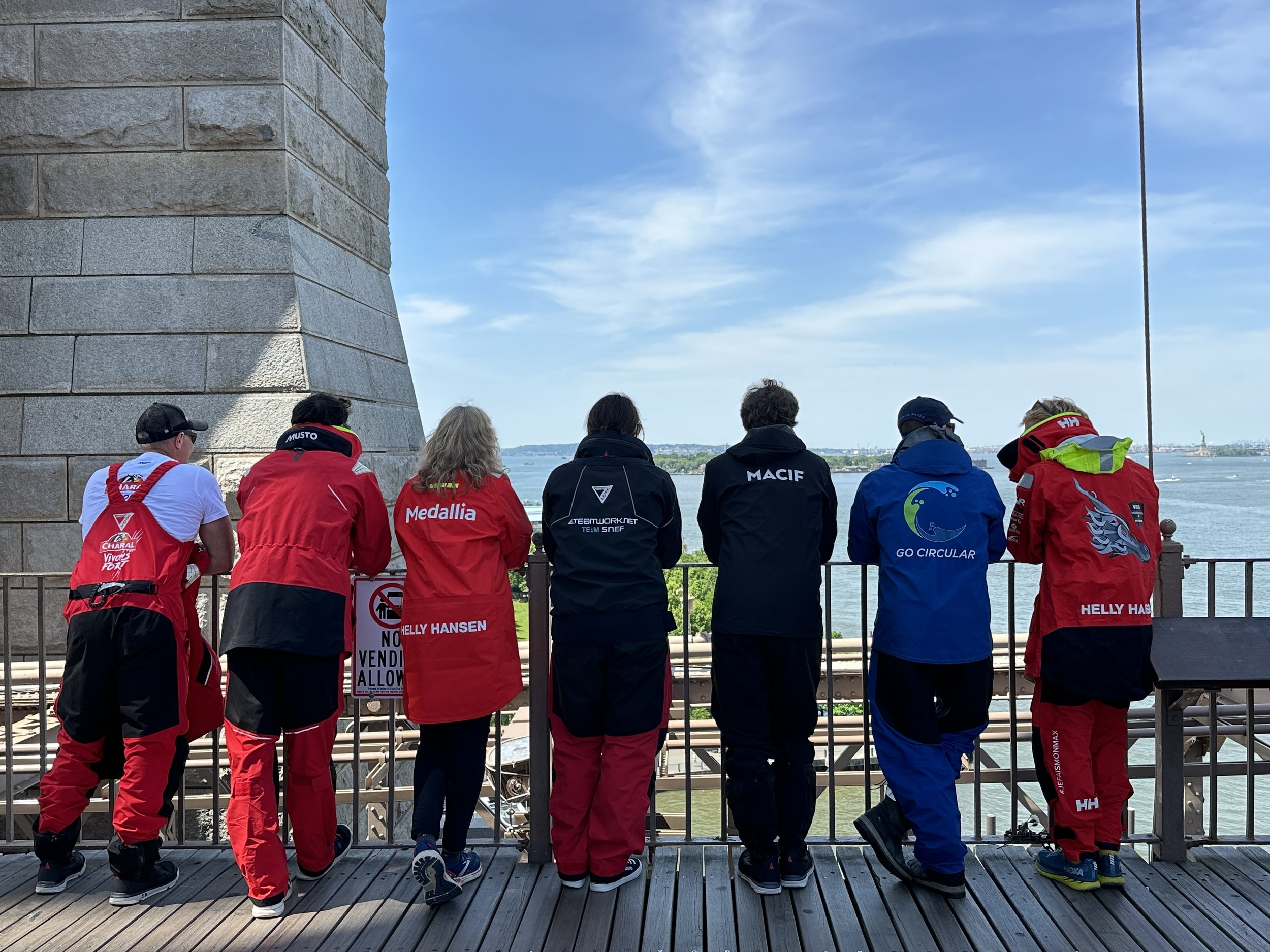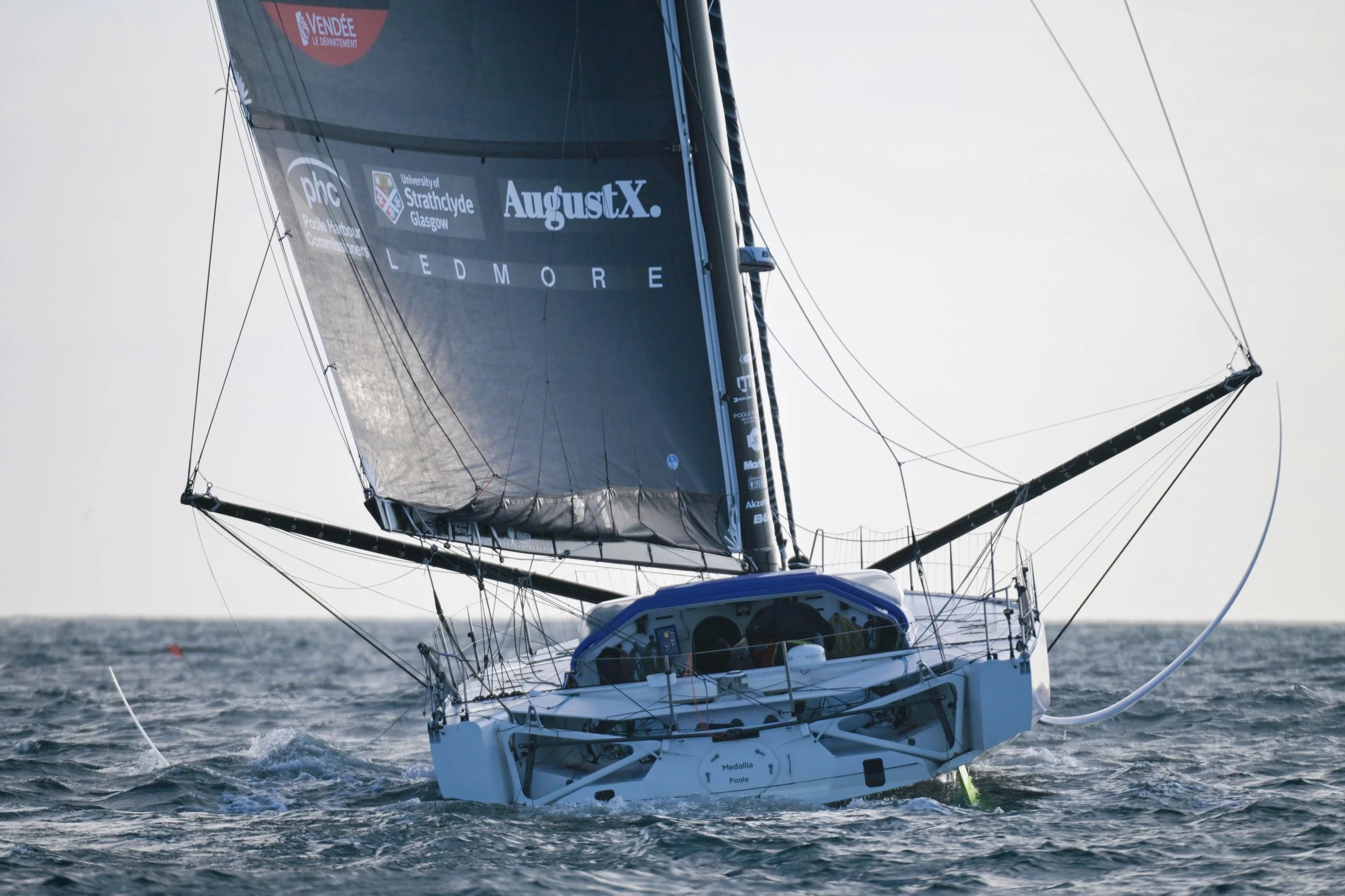New York Vendée Race
If you look closely at the footage of Medallia crossing the finish line of the New York Vendée Race in early June this year, you will see a red clad figure, dancing up and down, punching the air and with a grin from ear to ear.
Finishing in 9th position in one of the most competitive top tens the IMOCA class has ever seen was the validation our team was looking for after three years of monumentally hard graft.
It has not been an easy start to 2024, terrible weather for our refit, losing sponsors, unsure of what our program for the rest of the year would look like and needing to make week by week decision to match our cashflow. But with the mentality of a sailor pushing through the worst conditions towards an oncoming weather front, we doubled down as a team, protected the things that were important and adjusted our pace to continue forward progress in the certainty that things would get better.
The New York Vendée Race was my final qualification race for the Vendée Globe which starts on November 10th this year. To confirm my place on the entry list I needed to start one solo race in 2024, and to have sailed a minimum of 700 miles on the course to bank enough miles to stay ahead of the boats behind me on the ranking table. That doesn’t sound like an onerous task. To date, and with one hand firmly gripping the wooden table beneath my computer, Medallia has finished every race we have started. The entry criteria for the Vendée Globe are not performance based (this will be changing for the 2028 edition of the race) so in theory I could “deliver” our boat to the finish line in a no stress configuration.
This race was about so much more than banking miles, it was our final chance to test, trial and validate the considerable changes we have made to Medallia over the last three years and it was my final opportunity to line up against the biggest names in solo ocean racing and put my own skills to the test.
Since 2022, we as a team, have been knocking on the door of the top ten IMOCA rankings. We are at a privileged time in the journey of the Vendée Globe and IMOCA class sailing, there are more teams than ever before bringing more events, greater sponsorship opportunities and a significantly higher level of competition that the class has ever enjoyed. When we started building the Pip Hare Ocean Racing Team in 2021, I remember feeling almost crushed when I realised how high the bar was being raised but it’s forced us as a team to think big, to make punchy decisions and to push ourselves beyond comfortable. I always believed we had the capability of consistent top ten performance, we invested time and money in significantly improving the boat, but with a string of 11th and 12th positions have never quite managed to convert on the water. The New York Vendée was our last chance to race the fleet before we head around the world, but after changing our mast and our rig rake (the angle at which the mast leans back in the boat), earlier in the season it was also the opportunity to demonstrate a glimpse of what we might be capable of when I race around the world in November.
Starting a race in a foreign country is normal for our team. We never have the luxury of home starts, being in familiar environments, using our own facilities and getting to go home at night. When race starts are trans-Atlantic, the pressure is much bigger. The team fly out, with no tools, no workshop, no spares and little knowledge of the facilities which might or might not be available at the other end. Stop overs are time bound, in this case we had only five working days to repair any damage done on my trans-Atlantic delivery and the prepare for a solo race home. We were stationed at Moonbeam marina in Brooklyn, which was a challenging location. With no shops or facilities for miles around, a small task of buying tape, sandpaper, cleaning products or even a cold drink turned in to timely marathon. We had loaded the boat up with extra tools and spares on the delivery out, but we could not bring everything and the penalty was I would race the boat home overweight with things I did not need.
Thankfully the job list on arriving to the US was not too huge, but the team still had to graft late in to the night to ensure I was race ready. Mid way through our preparations, we took a day out to participate in the Liberty race; a flight of speed trials staged next to the statue of Liberty. The day was light airs so speed was not high on the agenda, instead the trials became about strategy and attention to detail. Our flight of six boats was tough, we were the only 2016 generation boat, against four newbuilds and a 2020 flier. We sailed the course twice in our allotted time and were over the moon to discover we had come second, with Charal leading the pack. It was a great moment and we sailed back down the Hudson River towards the marina, buoyed up by holding our own against the big dogs.
While the team worked, I was balancing trying to rest, preparing for the race ahead and managing the media requirements from the race organisers. These included a photoshoot in the middle of New York city, dressed up in full foul weather gear in the beating sunshine, standing on Brooklyn bridge, on crosswalks in the city, by grates with steam rising from the metro beneath. It was fun, and hot and confused a lot of people walking around the city.
As ever, before the start I sat down and mapped out what my race objectives should be. They came in three categories: technical, performance, personal.
Technical: Gather information about charging systems, how long and in what wind range the hydro-generators could be used. Test both autopilots under pressure. Try a race without using the lateral ballast. Create a job list for the refit
Performance: Having changed the rake earlier in the year, and sailing with a New Mainsail any opportunity to line up against other boats and compare performance would be invaluable. I needed to record settings on the pilot and the sails when the boat was going well. The whole team knew it was time for a top ten result but the fleet in this race was hot, on paper, based on boat age and design I was ranked joint 19th with Benjamin, Guyot Water Environment and Romain, Fortinet Best Western. The three of us all had 2016 boats converted to big foils, the rest of the fleet above us consisted of ten new builds and six 2020 generation foilers, all with V2 foils. As ever, it is important to define success before a race, if I made it purely based on a top ten finish, sailed a blinder of a race, but just fell outside the top ten then it would be crushing to think we had not achieved.
So, my performance objectives were to sail a race without mistakes, to make good navigational choices, to not give miles away unnecessarily and make sure I was always on the best sail choice and a good course. If I managed that I believed I could end up in the top ten. We would see.
Personal: It has been an incredibly stressful six months so far. Managing the budget of our team against the ticking of our Vendée countdown has kept me awake most nights. Having spent most waking hours in meetings or at a computer late in to the night my physical fitness has taken a hit and I knew going in to this race I was incredibly tired. I needed to work hard on managing myself during this race. I needed to switch off the worry in my brain, be in the moment, focus on my sport and my love for the sport. Make the most of everything we have created over the last three years and drink it all in. I would need to manage my energy levels and my sleep and recharge my motivation and passion for our final push to the start of the Vendée Globe Race.
The race start was unusual, as the fleet was hosted in both New York and Newport, we had agreed a virtual start line, offshore, equidistant to each city to which every skipper must sail in solo configuration. It was strange leaving the dock with no fanfare, just slipping out, saying good bye to the team and heading out alone. But I like the opportunity to settle in. The stopover had been exhausting and stressful so a 24hr period to decompress suited my head well. By the time I arrived at the start line I had shed off the stress of the land and was looking forward to the ocean ahead.
The race start was in light airs, all boats came together, we received our warning signals over WhatsApp message, co-ordinated with the time on our GPS devices. There was no one to see but we started like any other race, jostling for position, all taking similar lines. It was exciting and felt like breathing out after the close intensity of New York City.
The race was going to be mentally challenging. The expected downwind sleigh ride was evidently not going to show. With the usual high-pressure system which sits over the Azores located much further north with a low pressure in its place the direct route was showing headwinds. There was no clear route open to the finish. In the first week we had to negotiate the gulf stream and its associated weather phenomenon and weather front, heading East along our track, always tantalisingly close but with a void of wind behind it.
Our first 18 hours was marked by light airs, and wild thunderstorms, caused by the heat of the gulf stream which I could feel through the thin hull of Medallia. It was hard to rest with constantly changing wind strengths and many boats close. At night the lightening lit up the sky. Manu Cousin in Coup de Pouce, was struck by lightning during the night and lost his wind instruments for the rest of the race. During the first morning I struggled to find the gears and accelerate with the rest of the fleet, it was frustrating. At moments I had great speed, but when the breeze died to nothing I was flopping around and struggling to make progress.
As the breeze filled in the whole fleet started moving, and slowly I found my rhythm. I was disappointed to have fallen back so far in the fleet already but determined this was not a fait acommpli. It was time to engage my strategy of sailing cleaning and positively. I put my head down, paid attention to the details and worked my way up through the fleet.
Ahead of me on the race track one of the most bizarre IMOCA races was unfolding. With the blocking high pressure still settled in the centre of the Atlantic, two boats had managed to cross the weather front and they now had to make a choice about which way to go. Boris Herrmann in Malizia Sea Explorer, chose a route to the North, above the high pressure. Charlie Dalin, in Macif, chose to tack upwind directly along the rhum line. With boats pointing in all directions, it hardly looked like a race at all.
By day three I had caught up the front pack of the remaining boats. Try as we might we had not been able to get across the weather front. I could see it ahead of me, sometimes I would reach the edge of the clouds, speed would pick up, I would be excited and think this was it. Then the front would move east, the skies above me would clear and the wind would drop. The front moved faster than I could and the opportunity was lost. I was not alone and it was now time to make a big strategy decision and that was to head South, around the bottom of the Azores a route that would take me around 2000 miles away from Boris Herrmann’s position at our furthest separation.
I headed South with my new pack. A cohort of new builds and 2020 boats, all top ten regulars. I was in esteemed company. This was a great opportunity and I was thrilled to find myself in this pack after a less than satisfactory start.
The next week of racing was some of the best in my life. I was sailing in incredible company, at close quarters with high performing boats and skippers. My highest position in the rankings was 6th. For days I was able to see other boats on my AIS or on the horizon, it gave me opportunities to test autopilot settings and sail trim, to compare Medallia’s performance in real time. And it was good.
I collected a huge amount of data and knowledge during the middle five days of the race, and I could see that Medallia was able to hold its own compared to the top boats in the fleet. My speed was good, I was not left in their wake. I trimmed and tweaked and tried hard to stay in contact with these legends of our fleet.
As we pulled around the bottom of the Azores, Charlie and Boris were making their own courses. It was obvious by then that Charlie would win, and Boris with his huge trajectory to the north would come in second. The race was now among our pack. A further seven boats, all at close quarters and all taking the same route. We had a final low pressure to negotiate to the East of the Azores and then would need to sail North for a further four days to the finish.
The final days of our race were a drag race, for which I knew I was under gunned. I hung on to the newer boats for as long as I could then had to concede and I slowly sailed backwards through the fleet, dropping from 7th down to 9th and watching the boats ahead pull away knowing I could never make it back to them in these conditions and these conditions would last for the rest of the race. I was sitting in 9th place. Louis Burton in Bureau Vallee was coming in hot behind me. The last 700 miles were excruciating and I was struggling to maintain my confidence, feeling powerless to get Medallia going any faster. Every tracker update I would look at Louis position and work out what his speed differential would need to be to overtake me in the time we had left. It was stressful and a little soul destroying and not a mindset that helped performance. But despite having said I was not going to use a top ten finish as my definition of success, having been consistently in the top ten for the last week it would be brutal not to finish there.
With 24hrs to the finish I finally relaxed and allowed myself to believe I was holding my 9th place. And then I started to celebrate. Medallia was flying. We had great speed. We were going to finish 9th. We had no technical problems over the course of the race. This was success. I ran to the foredeck and did a little dance as I crossed the line. It felt incredible.
After three years of hard slog, of struggles, of punchy decisions and choices to take the hard road. Our boat, our team and me as a skipper had over the last 12 days demonstrated we belonged in the top ten of the IMOCA world. It is hard to describe how this validation has felt. I always knew we as a team were capable of this level of performance. To now be able to demonstrate this through unadulterated sport at the highest level feels great. The joy and pride have spread through the whole team. This recognition is for us all.
We have celebrated and acknowledged our success, then are straight back in to the program. As I write Medallia is in many parts in the shed at Endeavour Quay having the final refit pre Vendée. There is a lot of work to do and little time. Happily, our fundraising over the last two months has given us enough security to deliver the essential items on our refit list which in itself is a relief.
I will write a different update about our fundraising in a few weeks but want to thank every person that has shared our story, contributed to our crowd fund, signed up to have their name on the inside of our boat or bought a mast or boom sticker. You are all part of the team now so I hope you feel the reflection of our incredible last race.
We will be in refit mode for a further five weeks, then back sailing again in August. The Vendée Globe is coming and there is no stopping it.
Pip x




